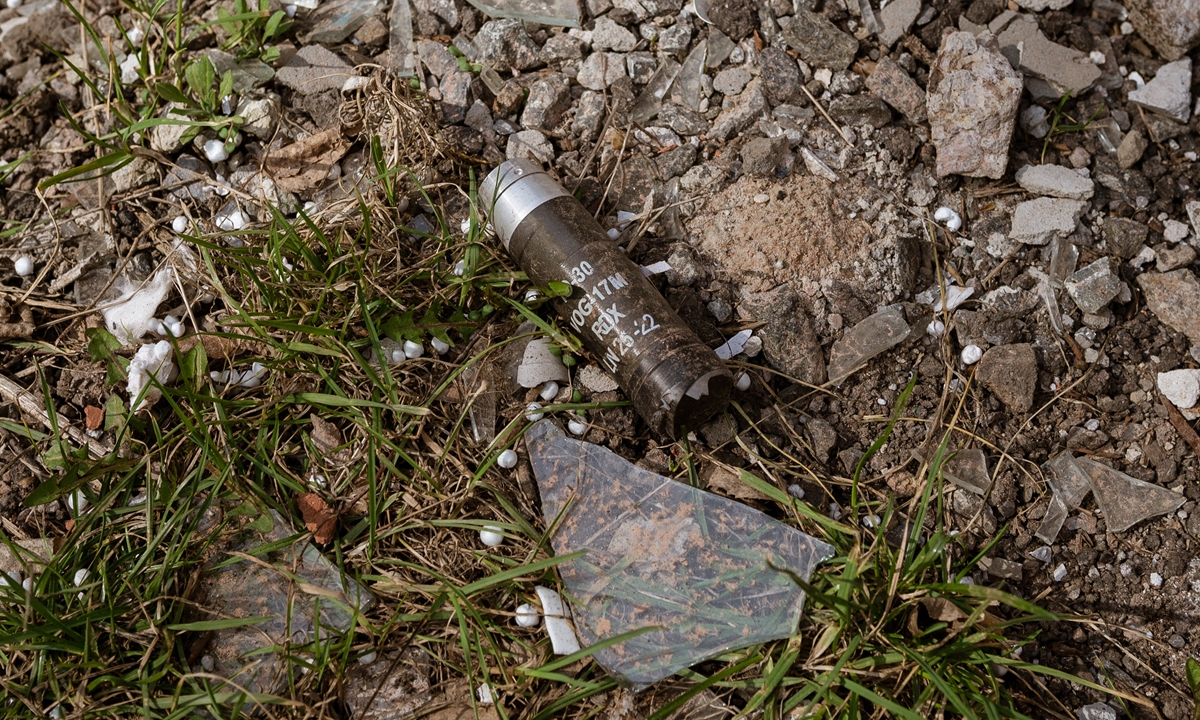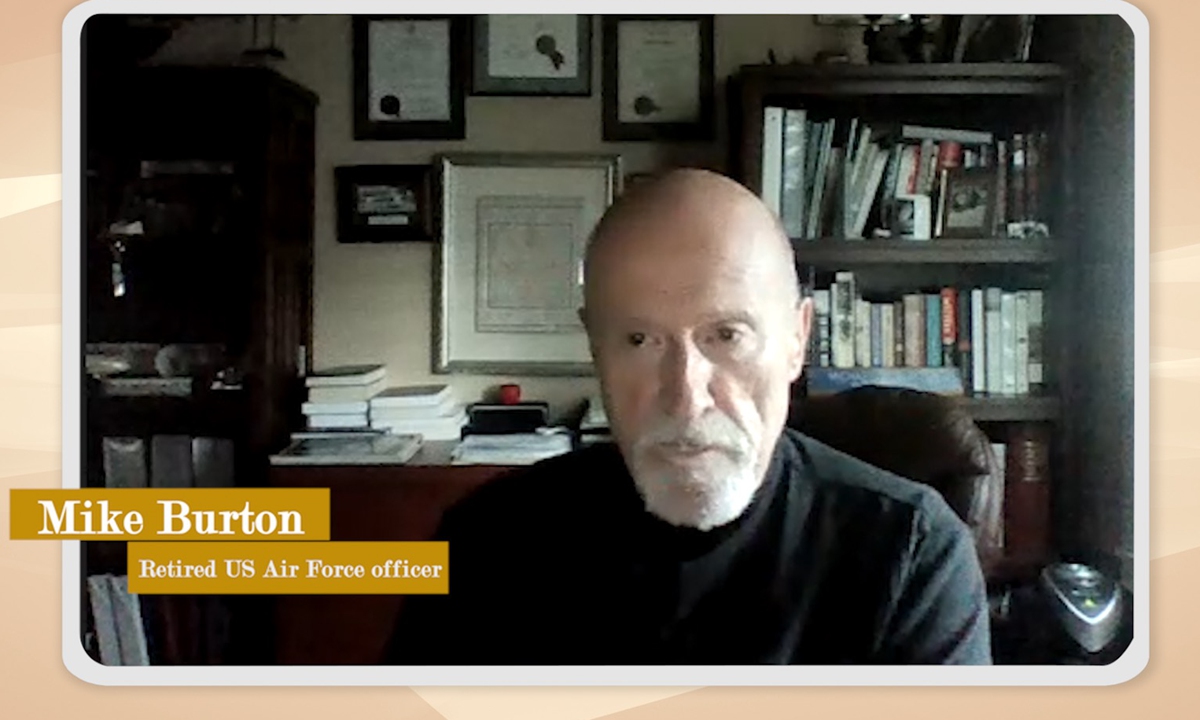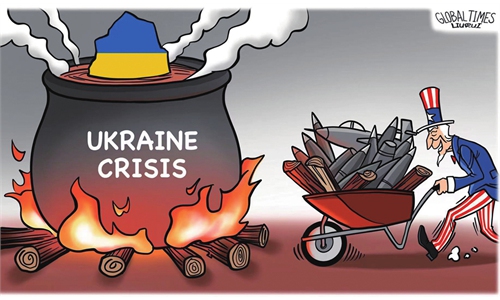IN-DEPTH / IN-DEPTH
Witness to history: US veteran in Vietnam War regrets dropping cluster bombs, feels hurt to see Ukraine repeat the nightmare
Editor's Note:
During the Vietnam War, the US used cluster bombs to carry out airstrikes on targets in Vietnam, Laos, and Cambodia. Over a period of nine years - from 1964 to 1973 - the US dropped more than two million tons of bomblets particularly in Laos, of which 80 million tons failed to detonate. Consequently, Laos now holds the unfortunate distinction of being the most heavily bombed country per capita in history.
Many fear that Ukraine, which has received many cluster bombs from the US, will become the next unfortunate casualty to share Laos' fate.
How does a US veteran who fought in the Vietnam War view the US' supply of cluster bombs to Ukraine? What do they feel it means to the legacy of their time on the ground? In conversation with one US Vietnam War veteran, the Global Times learned the answers to this question and more.
This story is a part of the Global Times' series of "Witness to history," which features first-hand accounts from witnesses who were at the forefront of historic events. From scholars, politicians and diplomats to ordinary citizens, their authentic reflections on the impact of historical moments help reveal a sound future for humanity through the solid steps forward taken in the past and the present.

The retired US Air Force officer now is the board chairman of Legacies of War. This organization raises awareness about the history of the bombing of Laos during the Vietnam War, and the organization will lead the US Campaign to Ban Landmines and Cluster Munitions this coming year.
In a recent exclusive interview with the Global Times, Burton expressed regret at dropping the inhumane cluster bombs on Laos, warning that "Ukraine shouldn't want this nightmare."
Burton, citing his own tragic memories, warned that the results will be deadly and disastrous for both the people of Ukraine and the US for decades to come, calling for the US government to be more cautious and accountable in its decision to send an $800-million military aid package which includes cluster munitions to Ukraine, a decision that has sparked widespread condemnation.
Dark memories of war
Burton joined the US Air Force in 1962 and was assigned to the 56th Air Commando Wing (ACW) in 1966. "The primary mission of the units to which I was assigned was to stop the flow of personnel and materials coming from North Vietnam through the Ho Chi Minh Trail to South Vietnam. The trail was located almost entirely in Laos," he explained.
"In my memory, overall, Laos was bombed every 8 minutes, 24 hours a day, for nine years. The aircraft assigned to the 56th ACW were a fixed-wing propellor-driven aircraft. The T-28 was the main aircraft used for interdiction along the trail. They could carry up to a 4000-pound payload. The B-52s dropped the majority of cluster bombs out of other bases. Besides, many bombs remained in the ground unexploded, in an intense land battle. The surface would be littered with a seemingly limitless number of every type of bomb used in ground combat, from cluster bomblets and artillery shells to hand grenades," Burton recalled to the Global Times.
He said that at least 30 to 40 percent of the cluster munitions didn't explode and he felt "so nervous" in using those bomblets, as the bomblets "indiscriminately fell into rice paddies and places that people were making a living."
"We think there are up to 80 million individual bomblets around or spread over the land area, some of them will never be removed," Burton sighed.
Cluster munitions are a type of explosive ordnance that can be launched from airplanes, missiles, or cannons, and can contain hundreds of submunitions, which are dispersed over a large area aerially, causing casualties and damage in a wider area. Cluster munitions do not have a targeting mechanism. What's even more alarming is that if these bomblets land on wet and soft ground, a significant portion of them can become "duds." The "duds" did not explode initially, but will explode later when subjected to external force or environmental changes.
"As one Laotian said, the 'bombs fell like rain,' and villages and entire valleys were obliterated. Countless civilians were killed," Burton recalled in a grave tone.
The US' bombing campaign was conducted in secrecy, only coming to light through a congressional hearing in 1971 and subsequent media reports. However, the true extent of the devastation caused by this "secret war" in Laos remains largely unknown to the American public, according to a report by CNN.
"Later, I came away from the war in Southeast Asia with very bad feelings about what we had and what had happened there. I saw [tragedies] both on the ground and from the air," Burton told the Global Times.
Those bomb bees look about the size of a play thing for a kid and a lot of the deaths occurred as there have been children who picked these things up and ended up losing their lives or arms or eyes, he noted bitterly, falling into solemn silence occasionally.
"I saw this destruction firsthand from the air and on the ground. I have seen Lao children and adults with missing limbs, eyes, and mutilated faces all from unexploded ordnances. The impact of our decision to drop cluster bombs on Laos also found its way to the US with waves of refugees fleeing death," Burton said.
In 1967, when Burton visited a village in Laos and asked a local villager, a school teacher, what he could offer as help, the reply was very short: "To leave."
"They said I'd like you to leave because you're going to get us killed," Burton said. "After two weeks, when I visited again, I was taken down an area where several people were assassinated in the square. And one of those was the school teacher who I talked to two weeks before. He was right. We got him killed."
According to reports, cluster munitions have a higher lethality than conventional ammunition. Since World War II, cluster munitions have caused approximately 56,500 to 86,500 civilian deaths. The US military used cluster munitions in the Vietnam War, Gulf War, Kosovo War, Afghan War, and Iraq War, resulting in significant damage to infrastructure and numerous civilian deaths and injuries.

Long road of redemption
In 2022, Burton, as the chair of the Legacies of War Board, had an opportunity to return to Laos and again felt deep sorrow when gazing down upon the land filled with many giant craters while on the plane.
"The scarred land is a reminder of America's deadly mistake, a reminder of the lives we took, and the ancient sites we obliterated," he suggested.
The veteran told the Global Times how he has suffered mentally and psychologically in dealing with his guilt after his return from the war, and had 14 months of therapy with the assistance of the US Department of Veterans Affairs.
"A lot of these young people came back, got into alcohol, drugs, anger, and the statistics from the Vietnam veterans is pretty bad with everything from suicide to just broken marriages and broken homes, and that sort of thing," he said.
This year marks the 50th year since the last American bombs were dropped in the Vietnam War. But the scars in Burton's heart have never been erased.
According to the Laos government, less than 10 percent of the deployed munitions have been destroyed.
"I have much to regret about the time I spent in the war; many things I try not to remember," said Burton, adding that he is now driven to make amends in any way that he can and speaks out to prevent future atrocities.
Burton later took part in the detonation of some of the unexploded ordnances in 2022 - work that is tedious, time consuming, and dangerous. He also started the Immigrant and Refugee Committee Organization, which serves a diverse group of immigrants and refugees from all over the world, including Ukraine.
Ukraine assured the US in early July that it wouldn't use cluster munitions in civilian areas, but once cluster munitions are deployed, no one can provide a definite answer as to whether such a promise will be strictly adhered to.
At least 38 human rights organizations have publicly opposed the US providing cluster munitions to Ukraine. These organizations state that since the outbreak of the Russia-Ukraine conflict, the numerous unexploded cluster munitions left behind by the war have posed a significant threat to the people of both Russia and Ukraine, causing great harm to many civilians.
"Now, the arms manufacturing people are probably already at Pentagon's doors saying, hey, we're here with a new contract you need to build. You just sell all of our reserves to Ukraine. I want to stop them from doing that," Burton said.
"If the US is really thinking and leaning toward doing that, I wish they would also sign a public document that said they will stand by the consequences of that. So that when the war is over, we will take care of clearing alarms. We will take care of caring for the children and the people who lose their arms and legs and eyes for the rest of their lives. And I want us to take responsibility for that," Burton concluded.
Zhang Xiaojuan also contributed to this story
During the Vietnam War, the US used cluster bombs to carry out airstrikes on targets in Vietnam, Laos, and Cambodia. Over a period of nine years - from 1964 to 1973 - the US dropped more than two million tons of bomblets particularly in Laos, of which 80 million tons failed to detonate. Consequently, Laos now holds the unfortunate distinction of being the most heavily bombed country per capita in history.
Many fear that Ukraine, which has received many cluster bombs from the US, will become the next unfortunate casualty to share Laos' fate.
How does a US veteran who fought in the Vietnam War view the US' supply of cluster bombs to Ukraine? What do they feel it means to the legacy of their time on the ground? In conversation with one US Vietnam War veteran, the Global Times learned the answers to this question and more.
This story is a part of the Global Times' series of "Witness to history," which features first-hand accounts from witnesses who were at the forefront of historic events. From scholars, politicians and diplomats to ordinary citizens, their authentic reflections on the impact of historical moments help reveal a sound future for humanity through the solid steps forward taken in the past and the present.

Photo: IC
Though more than 50 years have passed, the heavy shower of bomblets dropped from airplanes he piloted on Laos' devastated lands remains a deep scar in retired US Air Force officer Mike Burton's mind. Participating in the extensive bombing of Laos during America's "secret war" in Vietnam War has become one of Burton's deepest regrets and a source of dark memories.The retired US Air Force officer now is the board chairman of Legacies of War. This organization raises awareness about the history of the bombing of Laos during the Vietnam War, and the organization will lead the US Campaign to Ban Landmines and Cluster Munitions this coming year.
In a recent exclusive interview with the Global Times, Burton expressed regret at dropping the inhumane cluster bombs on Laos, warning that "Ukraine shouldn't want this nightmare."
Burton, citing his own tragic memories, warned that the results will be deadly and disastrous for both the people of Ukraine and the US for decades to come, calling for the US government to be more cautious and accountable in its decision to send an $800-million military aid package which includes cluster munitions to Ukraine, a decision that has sparked widespread condemnation.
Dark memories of war
Burton joined the US Air Force in 1962 and was assigned to the 56th Air Commando Wing (ACW) in 1966. "The primary mission of the units to which I was assigned was to stop the flow of personnel and materials coming from North Vietnam through the Ho Chi Minh Trail to South Vietnam. The trail was located almost entirely in Laos," he explained.
"In my memory, overall, Laos was bombed every 8 minutes, 24 hours a day, for nine years. The aircraft assigned to the 56th ACW were a fixed-wing propellor-driven aircraft. The T-28 was the main aircraft used for interdiction along the trail. They could carry up to a 4000-pound payload. The B-52s dropped the majority of cluster bombs out of other bases. Besides, many bombs remained in the ground unexploded, in an intense land battle. The surface would be littered with a seemingly limitless number of every type of bomb used in ground combat, from cluster bomblets and artillery shells to hand grenades," Burton recalled to the Global Times.
He said that at least 30 to 40 percent of the cluster munitions didn't explode and he felt "so nervous" in using those bomblets, as the bomblets "indiscriminately fell into rice paddies and places that people were making a living."
"We think there are up to 80 million individual bomblets around or spread over the land area, some of them will never be removed," Burton sighed.
Cluster munitions are a type of explosive ordnance that can be launched from airplanes, missiles, or cannons, and can contain hundreds of submunitions, which are dispersed over a large area aerially, causing casualties and damage in a wider area. Cluster munitions do not have a targeting mechanism. What's even more alarming is that if these bomblets land on wet and soft ground, a significant portion of them can become "duds." The "duds" did not explode initially, but will explode later when subjected to external force or environmental changes.
"As one Laotian said, the 'bombs fell like rain,' and villages and entire valleys were obliterated. Countless civilians were killed," Burton recalled in a grave tone.
The US' bombing campaign was conducted in secrecy, only coming to light through a congressional hearing in 1971 and subsequent media reports. However, the true extent of the devastation caused by this "secret war" in Laos remains largely unknown to the American public, according to a report by CNN.
"Later, I came away from the war in Southeast Asia with very bad feelings about what we had and what had happened there. I saw [tragedies] both on the ground and from the air," Burton told the Global Times.
Those bomb bees look about the size of a play thing for a kid and a lot of the deaths occurred as there have been children who picked these things up and ended up losing their lives or arms or eyes, he noted bitterly, falling into solemn silence occasionally.
"I saw this destruction firsthand from the air and on the ground. I have seen Lao children and adults with missing limbs, eyes, and mutilated faces all from unexploded ordnances. The impact of our decision to drop cluster bombs on Laos also found its way to the US with waves of refugees fleeing death," Burton said.
In 1967, when Burton visited a village in Laos and asked a local villager, a school teacher, what he could offer as help, the reply was very short: "To leave."
"They said I'd like you to leave because you're going to get us killed," Burton said. "After two weeks, when I visited again, I was taken down an area where several people were assassinated in the square. And one of those was the school teacher who I talked to two weeks before. He was right. We got him killed."
According to reports, cluster munitions have a higher lethality than conventional ammunition. Since World War II, cluster munitions have caused approximately 56,500 to 86,500 civilian deaths. The US military used cluster munitions in the Vietnam War, Gulf War, Kosovo War, Afghan War, and Iraq War, resulting in significant damage to infrastructure and numerous civilian deaths and injuries.

Photo: Global Times
Long road of redemption
In 2022, Burton, as the chair of the Legacies of War Board, had an opportunity to return to Laos and again felt deep sorrow when gazing down upon the land filled with many giant craters while on the plane.
"The scarred land is a reminder of America's deadly mistake, a reminder of the lives we took, and the ancient sites we obliterated," he suggested.
The veteran told the Global Times how he has suffered mentally and psychologically in dealing with his guilt after his return from the war, and had 14 months of therapy with the assistance of the US Department of Veterans Affairs.
"A lot of these young people came back, got into alcohol, drugs, anger, and the statistics from the Vietnam veterans is pretty bad with everything from suicide to just broken marriages and broken homes, and that sort of thing," he said.
This year marks the 50th year since the last American bombs were dropped in the Vietnam War. But the scars in Burton's heart have never been erased.
According to the Laos government, less than 10 percent of the deployed munitions have been destroyed.
"I have much to regret about the time I spent in the war; many things I try not to remember," said Burton, adding that he is now driven to make amends in any way that he can and speaks out to prevent future atrocities.
Burton later took part in the detonation of some of the unexploded ordnances in 2022 - work that is tedious, time consuming, and dangerous. He also started the Immigrant and Refugee Committee Organization, which serves a diverse group of immigrants and refugees from all over the world, including Ukraine.
Ukraine assured the US in early July that it wouldn't use cluster munitions in civilian areas, but once cluster munitions are deployed, no one can provide a definite answer as to whether such a promise will be strictly adhered to.
At least 38 human rights organizations have publicly opposed the US providing cluster munitions to Ukraine. These organizations state that since the outbreak of the Russia-Ukraine conflict, the numerous unexploded cluster munitions left behind by the war have posed a significant threat to the people of both Russia and Ukraine, causing great harm to many civilians.
"Now, the arms manufacturing people are probably already at Pentagon's doors saying, hey, we're here with a new contract you need to build. You just sell all of our reserves to Ukraine. I want to stop them from doing that," Burton said.
"If the US is really thinking and leaning toward doing that, I wish they would also sign a public document that said they will stand by the consequences of that. So that when the war is over, we will take care of clearing alarms. We will take care of caring for the children and the people who lose their arms and legs and eyes for the rest of their lives. And I want us to take responsibility for that," Burton concluded.
Zhang Xiaojuan also contributed to this story



